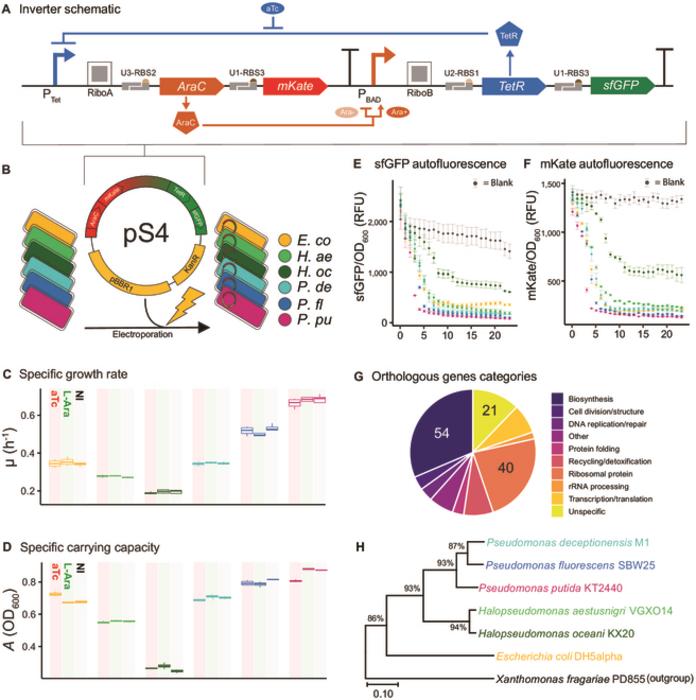Synthetic biology is a growing discipline of science that involves redesigning naturally occurring organisms to express new, useful attributes. These engineered organisms can be used to address issues unresolved by conventional methods.

Credit: BioDesign Research
Synthetic biology is a growing discipline of science that involves redesigning naturally occurring organisms to express new, useful attributes. These engineered organisms can be used to address issues unresolved by conventional methods.
Broad-host-range (BHR) synthetic biology is an emerging domain that aims to expand the pool of model hosts or ‘chassis,’ by utilizing the rich diversity of the naturally evolving microbial world. The chassis provides a platform for the expression of heterologous genes derived from different organisms. These have to be genetically engineered before they can function. While exploring this new dimension, synthetic biologists have discovered that genetic circuits (assemblies of biological parts encoding RNA or protein) function differently depending on the host environment. This phenomenon, known as the “chassis effect,” may hinder the development of engineered organisms. However, there is a paucity of information regarding the underlying biological properties responsible for the chassis effect.
To fill this knowledge gap, Professor Hans C. Berstein, from The Arctic University of Norway, and colleagues set out to investigate the correlation of phylogenomic and physiological relatedness to genetic circuit performance. Their study was published in Volume 5 of BioDesign Research on 16th August 2023.
Professor Berstein remarks, “Filling this knowledge gap will not only help mitigate the degree of uncertainty caused by the chassis effect, but also provide more predictive power to BHR synthetic biology applications and contribute to broadening the design space available for biodesign applications.”
Previous studies have shown that genome relatedness (related based on identical gene alleles by descent) as well physiological attributes may be potential predictors of genetic circuit performance. However, these studies have only assessed single or few attributes within a single chassis model. To overcome this drawback, the researchers conducted a comprehensive analysis accounting for a huge range of variables in both model and non-model organisms. They demonstrated the chassis effect by characterizing the performance of a genetic inverter circuit (a genetically engineered circuit that receives concentration of one repressor as input and sends the concentration of another repressor as output) in six different Gammaproteobacteria species.
First, they assembled plasmid pS4 by cloning the genetic circuit inverter into a pSEVA231 vector (vehicle) with the biopart assembly standard for idempotent cloning (BASIC) protocol. The inverter contained two inducible antagonistic expression cassettes with mKate (red fluorescent protein) and Superfolder GFP (sfGFP, green fluorescent protein) as reporters. This circuit could be induced using both L-arabinose (Ara) and anhydrotetracycline (aTc).
Next, they used electroporation to introduce pS4 (containing inverter) into six Gamma proteobacteria species, namely, E. coli, H. aestusnigri, H. oceani, Pseudomonas deceptionensis M1, P. fluorescens, and P. putida. From the growth pattern analysis of the genetically engineered bacteria and their wild type (non-engineered) counterparts, they found that closely related hosts shared similar physiologies.
Next, they moved on to compare the effect of phylogenomic relatedness on inverter expression with host physiology. Flowcytometric analysis revealed that although all inverter containing hosts emitted fluorescent signals upon induction, there were differences in the inverter expression between hosts, establishing a clear and quantifiable chassis effect.
To quantify the chassis effect, host fluorescence under same induction conditions were assessed using the toggle assay. The researchers found that the same inverter circuit performed quite differently in physiologically dissimilar chassis. The researchers then moved onto evaluate if chassis effect was more impacted by host physiology or by phylogenomic relatedness. Both tests revealed that inverter performance was correlated only with host physiology and not phylogenomic relatedness. This confirmed host physiology attributes to be an effective and reliable predictor of inverter circuit performance within Gammaproteobacteria hosts.
Prof. Hans concludes by saying, “As we domesticate more pragmatic microbes as novel chassis, our ability to control and predict host context effect must also advance. our findings contribute to this goal by improving prediction of the chassis effect.”
Overall, this study paves the way for the beginning of a new advanced chapter in synthetic biology. It is clearly possible to have genetic circuits/devices in non-model or less established-model organisms used for biological studies.
###
References
Authors
Dennis Tin Chat Chan1, Geoff S. Baldwin2,3, and Hans C. Bernstein1,4
Affiliations
1Faculty of Biosciences, Fisheries and Economics, UiT, The Arctic University of Norway, 9019 Tromsø, Norway.
2Department of Life Sciences, Imperial College London, South Kensington, London SW7 2AZ, UK.
3Imperial College Centre for Synthetic Biology, Imperial College London, South Kensington, London SW7 2AZ, UK.
4The Arctic Centre for Sustainable Energy, UiT, The Arctic University of Norway, 9019 Tromsø, Norway.
About Professor Hans C. Bernstein
Dr. Bernstein is a Professor at the Faculty of Biosciences, and the Arctic Centre for Sustainable Energy (ARC), UiT, The Arctic University of Norway. He is a chemical engineer specializing in genome-enabled systems and synthetic biology of microbes and microbial communities. His research is at the intersection of biotechnology and microbial ecology as applied to the fields of marine microbiomes, synthetic biology, and algal biotechnology. Prof. Bernstein has close to 50 publications to his credit with a h-index of 22, and holds a registered patent.
Journal
BioDesign Research
DOI
10.34133/bdr.0016
Method of Research
Experimental study
Subject of Research
Not applicable
Article Title
Revealing the Host-Dependent Nature of an Engineered Genetic Inverter in Concordance with Physiology
Article Publication Date
16-Aug-2023
COI Statement
The authors declare that they have no competing interests.




